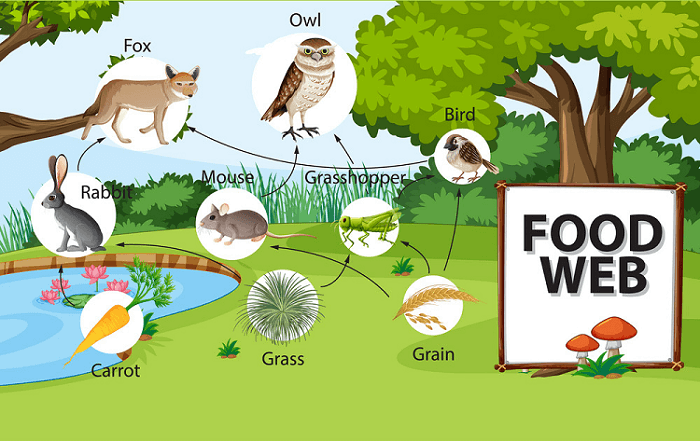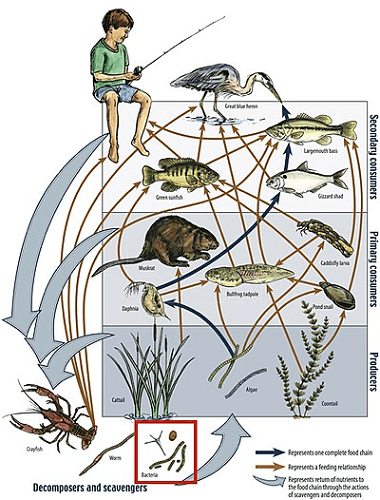Food Web Definition
All the food networks in a single ecosystem make up a food web. Each organism in an ecosystem is a link in several food chains. Energy and nutrients can go along different food chains as they move through the ecosystem. A food web comprises an ecosystem's linked and overlapping food systems.
Thrill Levels
The trophic levels are divisions into which organisms in food webs are categorized. These levels can be roughly categorized as producers (first trophic level), consumers, and decomposers (last trophic level).
Producers
- The first trophic level is producers. Producers, often called autotrophs, produce all their food and do not rely on other living things for sustenance. The majority of autotrophs convert sunlight, carbon dioxide, and water into food (a nutrient called glucose) through a process known as photosynthesis.
- The most well-known type of autotroph is a plant, but numerous others exist. Algae are autotrophic, and their larger forms are known as seaweed. Autotrophs include the small sea life known as phytoplankton. Autotrophic bacteria include certain varieties. For instance, microorganisms living near active volcanoes make their food using sulfur rather than carbon dioxide. Chemosynthesis is the name of this process.

Consumers
- Animals that eat producers make up the next trophic tiers. These creatures are referred to as consumers.
- Consumers might be omnivores or carnivores, or animals that consume other animals (animals that eat both plants and animals). Like humans, omnivores eat a variety of foods. People consume plant foods like fruits and vegetables. We consume meat, milk, other animal products, and eggs. We consume fungus like mushrooms.
- Additionally, humans consume algae found in edible seaweeds like nori, which is used to make sushi rolls, and sea lettuce (used in salads). Bears are also omnivores. They consume fish and deer as well as berries and mushrooms.
- Herbivores are the main consumers. Herbivores consume plants, algae, and other producers. At the second trophic level, they are. Deer, mice, and even elephants are herbivores in an ecosystem of grasslands. They consume trees, shrubs, and grasses. A mouse that consumes seeds and fruits is the main consumer in desert ecology.
- Numerous fish and turtle species in an ocean ecosystem are herbivores that consume algae and seagrass. Giant kelp, a type of seaweed, supports a complete ecosystem in kelp forests by offering shelter and food. In kelp forests, sea urchins are significant primary consumers. These small herbivores consume several pounds (kg) of enormous kelp daily.
- Secondaries consume herbivores. At the third trophic level, they are. A snake that consumes a mouse may be a secondary consumer in a desert ecosystem. Sea otters are secondary consumers that seek sea urchins in the kelp forest.
- Tertiary consumers eat secondary consumers. At the fourth trophic level, they are. A snake may be eaten by an owl or an eagle in the desert ecosystem.
- Before a chain eventually reaches its top predator, there may be further layers of customers. Apex predators, or top predators, consume other consumers. They could be at trophic level four or five. Except for people, they have no natural adversaries. The top predators in the ecology of grasslands are lions. Fish like the great white shark are the top predators in the water. Mountain lions and bobcats are the main predators in the desert.
Decomposers and Detritivores
- The final link in a food chain comprises detritivores and decomposers. Organisms known as detritivores consume dead plant and animal remnants. Scavengers, like vultures, for instance, consume dead animals. Dung bugs consume animal waste.
- Decomposers like fungi and bacteria finish the food chain. Decomposers convert organic wastes, such as decaying plants, into inorganic materials, such as nutrient-rich soil. By returning nutrients to the soil or oceans for use by autotrophs, they complete the life cycle. With this, a brand-new chain of restaurants is launched.
Food Flow
- Food webs connect many distinct trophic levels and food chains. Food chains can be relatively small or very long and complex in food webs.
- For instance, grass in a clearing in a forest makes its food through a process called photosynthesis. A bunny consumes some grass. Eaten by a fox, the rabbit. When a fox dies, its body is broken down by decomposers like worms and mushrooms and returned to the soil, where it feeds grass-like plants.
- One link in the fast food chain that makes up the forest's food web. A distinct food chain may contain entirely different creatures in the same habitat. A caterpillar may consume the leaves of a forest tree. A sparrow or other bird might consume the caterpillar. The sparrow might then fall victim to a snake. The snake might be preyed upon by an eagle, an apex predator. A vulture, yet another bird, eats the deceased eagle's body. Finally, the leftovers are broken down by microbes in the soil.
Biomass
- Biomass is a key factor in defining food webs. The energy in living things is called biomass. The producers in a food chain, known as autotrophs, transform solar energy into biomass. Each trophic level causes the biomass to drop. Lower trophic levels always have more biomass than higher ones do.
- In a balanced food web, there are always more autotrophs than herbivores because biomass declines with each trophic level. Carnivores are less prevalent than herbivores. An ecosystem must support more herbivores and autotrophs to sustain many omnivores.
- There are many autotrophs, many herbivores, and very few carnivores and omnivores in a healthy food web. The ecology can sustain and recycle biomass because of this balance.
- In a food web, each link is interconnected with at least two additional links. An ecosystem's biomass is influenced by how well-balanced and integrated its food chain is. All or some of the links in the food chain are weakened or strained when one link is endangered. Biomass in the ecosystems decreases.
- For instance, a fall in the population of herbivores is typically brought on by the loss of plant life. Drought, illness, or human activities can all cause a decrease in plant life. To supply lumber for construction, forests are cut down. Grasslands are paved over to make way for parking lots or shopping centers.
- A food web can also become out of balance due to biomass loss on the second or third trophic level. Think about the potential outcomes if a salmon run is interrupted. A river where the salmon swim is known as a salmon run. Landslides, earthquakes, the building of dams and levees, and salmon flows can all be affected.
- Salmon being removed from rivers results in a loss of biomass. Omnivores like bears must rely more heavily on alternative food sources like ants because they can't consume salmon. The number of ants in the area decreases. Since ants are typically scavengers and detritivores, less soil nutrient breakdown occurs. Biomass is lost because the soil can't support as many autotrophs. The salmon itself eat smaller fish and bug larvae. Aquatic insects may wreak havoc on nearby plant populations if salmon cannot control their numbers. Plant survival rates are lower, and biomass is lost. A food chain can be upset by the disappearance of creatures at higher trophic levels, such as carnivores. Sea urchins are the main kelp consumers in kelp forests. Sea otters eat urchins for food. Urchins wreak havoc on the kelp forest if the sea otter population declines due to sickness or killing. Biomass declines in the absence of a producer community. The whole kelp forest vanishes. Urchin barrens are the name for such places.
- The number of predators can be decreased by human activity. Venezuelan authorities dammed the Caroni River in 1986, resulting in a massive lake roughly twice the size of Rhode Island. In this lake, hundreds of hilltops have transformed into islands. Many terrestrial predators needed more food since their habitats had been limited to tiny islands. Predators flourished, including iguanas, leaf-cutter ants, and howler monkeys. Because there were so many ants, the rainforest was completely ruined, killing all the trees and other flora. The Caroni River's surrounding food chain was decimated.

Bioaccumulation
- As you ascend through the trophic layers, biomass decreases. However, some substances-most notably poisonous chemicals-increase with each trophic level of the food chain. Typically, these compounds gather in animal fat.
- For instance, pesticides are deposited in the fat of herbivores when they consume plants or other autotrophs coated in pesticides. A carnivore ingests the pesticide compounds stored in its prey when it consumes several herbivores. We refer to this process as bioaccumulation.
- Additionally, bioaccumulation occurs in aquatic settings. There may be a lot of toxins in the runoff from farms or urban areas. Small producers like seagrass, bacteria, and algae absorb these contaminants in small quantities. Seagrass is consumed primarily by fish and marine turtles. They consume the nutrients and energy the plants offer while storing the chemicals in their fatty tissue. Predators on the third trophic level, such as sharks and tuna, consume fish. Tuna may have significant bioaccumulated poisons stored when people eat it.
- Some contaminated habitats have creatures that are dangerous to consume and cannot be collected due to bioaccumulation. For example, eating oysters from New York City, United States harbor is dangerous. The oysters in the harbor, which are filter feeders, gather the contaminants.
|


 For Videos Join Our Youtube Channel: Join Now
For Videos Join Our Youtube Channel: Join Now










